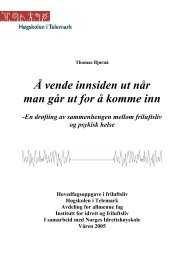Green Care: A Conceptual Framework - Frisk i naturen
Green Care: A Conceptual Framework - Frisk i naturen
Green Care: A Conceptual Framework - Frisk i naturen
Create successful ePaper yourself
Turn your PDF publications into a flip-book with our unique Google optimized e-Paper software.
Whilst green care in general does not explicitly propose any spiritual<br />
philosophy or advocate any religious views it is highly likely that for some<br />
people working in the natural environment fulfils deeper spiritual needs.<br />
References<br />
Fox, M. (2000) Original Blessings. Los Angeles: J.P. Tarcher.<br />
Paffard, M. (1973) Inglorious Wordsworths: A study of some transcendental experiences in childhood<br />
and adolescence. London: Hodder and Stoughton,<br />
Quiet Garden Movement. (2008) http://www.quietgarden.co.uk/quiet_garden_ministry.htm, accessed<br />
February 2008.<br />
Unruh, A. M. (2004) ‘The meaning of gardens and gardening in daily life: a comparison between<br />
gardeners with serious health problems and healthy participants’. Acta Horticulturae, 639, 67-73.<br />
6.13 Jungian Psychology<br />
Jungian Psychology, also known as Analytic Psychology or Jungian<br />
Psychoanalysis, is derived from the work of C. G. Jung. Jung was one of<br />
Freud’s earliest collaborators who broke away from the psychoanalytic<br />
orthodoxy when he found it too mechanistic and drive-based. His path<br />
was to follow a less deterministic view of human nature – one which<br />
gave prominence to the deep meaning of experience. This indeed includes<br />
spiritual, transcendental, numinous and mystical meanings, which he<br />
elaborated following his work with psychoanalysis of psychotic patients.<br />
Earlier Jungian work included his character types (Jung, 1921), and<br />
personality dimensions – his best known and widely used coinage is that<br />
of the qualities of extraversion and introversion. The measurement of<br />
character traits came into widespread use in both the world of academic<br />
psychology (as part of the foundation of the five axis dimensional<br />
assessment of personality, see Goldberg, 1992) and management training<br />
(where they form the basis of the Myers-Briggs typography, see: Myers et<br />
al, 1998).<br />
Synchronicity is an important concept in Jungian metapsychology (Storr,<br />
1973): it gives meaning to connections which are not causal, and recognises<br />
connections between the psyche and the external world. Jung refers<br />
synchronous events as ‘acts of creation in time’, showing the on-going<br />
generative powers of Nature. Susan Rowland relates this to the creation<br />
myth and archetype of the Earth-Mother (Rowland, 2006).<br />
88 <strong>Green</strong> <strong>Care</strong>: A <strong>Conceptual</strong> <strong>Framework</strong>















